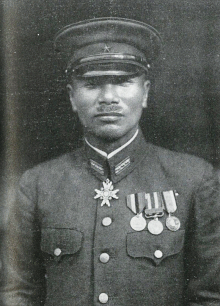Ichiki Kiyonao
Ichiki Kiyonao ( Japanese 一 木 清 直 ; born October 16, 1892 in Shizuoka Prefecture , Japan ; † August 21, 1942 in Guadalcanal ) was a colonel in the Imperial Japanese Army .
Life
Early life
Ichiki graduated from the Imperial Japanese Army Academy in 1916 and then taught as a trainer at the Army Infantry School in Chiba Prefecture .
Second Sino-Japanese War
After his promotion to major in 1934, Ichiki was transferred to the China Garrison Army in 1936 , where he commanded a battalion of the 1st Infantry Regiment. On the night of July 7, 1937, the Japanese Army conducted an exercise to simulate the capture of the Marco Polo Bridge in Shanghai . For this purpose there were several fires in the air. Chinese soldiers, fearing a real Japanese attack on the bridge, fired some inaccurate artillery volleys in the direction they suspected the Japanese were heading. This caused a panic-like escape and general chaos for them. In this one of the soldiers failed to report to his superior in time the next morning. Ichiki, to whose battalion the soldier belonged, assumed he had been captured by the Chinese and ordered an immediate attack on Wanping to rescue him . This was the beginning of the so-called incident at the Marco Polo Bridge , which triggered the Second Sino-Japanese War .
Soon after, Ichiki was ordered back to Japan, where he served as an instructor at various schools for special equipment from 1938 to 1940.
Pacific War
At the beginning of the Pacific War Ichiki was promoted to colonel and was given command of the 28th Infantry Regiment of the 7th Division , consisting of about 3,000 soldiers. This force was intended to capture and secure the island in the Battle of Midway . However, the defeat of the Imperial Japanese Navy in battle led to the operation being abandoned.
In August 1942 Ichiki and his regiment were subordinated to the 17th Army , which had its headquarters on Truk . After Allied forces landed on Guadalcanal, an island in the Solomon Islands , Ichiki was also sent to the island with two battalions of his regiment, a total of 916 men, to intervene in the battle of Guadalcanal, to recapture the strategically important airfield Henderson Field and the Americans to enter Drifting sea.
On August 19, six Japanese destroyers Ichiki and his soldiers landed at Taivu Point on Guadalcanal. He had strict orders to build a beachhead and wait for reinforcements. However, since he did not encounter any significant resistance and therefore greatly underestimated the strength of the Allied troops, he decided to leave 125 men behind as security and to carry out a night frontal attack with the rest against the supposedly unsuspecting enemy, who in reality has more than 11,000 men stationed on the island would have. However, he had taken note of his landing and was waiting for him in strongly fortified positions. In the following Battle of Tenaru on August 21, Ichiki's force was repulsed and almost completely wiped out. Ichiki himself was killed in battle.
There are two versions of how Ichiki died. The first assumes that he was killed in action, the second that he committed ritual suicide because of the shame of his misjudgment and defeat . Despite the defeat, he was nevertheless posthumously promoted to major general.
Remarks
- ^ Smith, Bloody Ridge , p. 32.
- ^ Spence, Jonathan D. The Search for Modern China . New York: Norton & Company, 1990, pp. 443-469.
- ↑ Harries, Soldiers of the Sun , 202.
- ^ Toland, The Rising Sun
- ^ Chen, World War II Database
literature
- James Crowley: A Reconsideration of the Marco Polo Bridge Incident, in Journal of Asian Studies , Issue XXII, No. 3 (May 1963).
- Trevor N. Dupuy : Encyclopedia of Military Biography , IB Tauris & Co. Ltd., 1992, ISBN 1-850-43569-3 .
- Richard B. Frank: Guadalcanal: The Definitive Account of the Landmark Battle , Random House, New York 1990, ISBN 0-394-58875-4 .
- Richard Fuller: Shokan: Hirohito's Samurai , Arms and Armor, London 1992, ISBN 1-854-09151-4 .
- Meirion Harries and Susie Harries: Soldiers of the Sun: The Rise and Fall of the Imperial Japanese Army , Random House, New York 1994, ISBN 0-679-75303-6 .
- Michael T. Smith: Bloody Ridge: The Battle that Saves Guadalcanal , Pocket, New York 2000, ISBN 0-743-46321-8 .
- Jonathan D. Spence: The Search for Modern China , Norton & Company, New York 1990, ISBN 0-812-96858-1 .
- John Toland: The Rising Sun: The Decline and Fall of the Japanese Empire, 1936-1945 , Pen & Swords Military Classics, 2005, ISBN 1-844-15304-5 .
Web links
| personal data | |
|---|---|
| SURNAME | Ichiki, Kiyonao |
| ALTERNATIVE NAMES | 一 木 清 直 (Japanese, Kanji) |
| BRIEF DESCRIPTION | Colonel in the Imperial Japanese Army |
| DATE OF BIRTH | October 16, 1892 |
| PLACE OF BIRTH | Shizuoka Prefecture , Japanese Empire |
| DATE OF DEATH | August 21, 1942 |
| Place of death | Guadalcanal |
